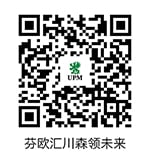In November 2016, UPM and Yara Finland, a leading fertiliser and crop nutrition expert, announced that they had been granted funding for a joint project to develop a recycled fertiliser. The two companies originally began collaborating earlier in 2016, with their first joint field trials carried out last summer with positive results. The promising project has now been granted funding for 2017–2018 by Raki2, a nutrient recycling programme administered by the Finnish Ministry of the Environment.
Agriculture has a long history of harnessing side streams; since early times, fields have always been fertilised with manure from farm livestock. The joint project between UPM and Yara aims to create a sustainable, industrial-scale fertiliser solution that specifically meets the needs of farmers. The fertiliser will be manufactured from side streams such as sludge (which contains nitrogen and phosphorus) from the effluent treatment plants of UPM’s pulp and paper mills, and possibly ash from the incineration of biomass.
“UPM’s role in the project is to provide the side stream material and to test and design the manufacturing technology and the manufacturing plant. The most important part of the design process is developing a suitable drying solution for the sludge,” explains Katja Viitikko, head of the side stream research programme at UPM Research & Development. Yara is in turn responsible for carrying out pot and field tests, organising collaboration with farmers, and positioning the product on the market.
Finding the perfect nutrient ratio
Fertiliser researcher Raimo Kauppila from Yara Finland has been working in the fertiliser industry for over 25 years and is the company’s key expert in important strategic projects. “The bio and primary sludge from UPM’s effluent treatment plants is relatively homogeneous organic material, but the nutrient composition is not ideal. If the sludge were to be used as it is, dozens of tonnes would need to be spread per hectare for it to make a difference. Our project focuses on examining which nutrients can be found in the side streams and how we need to supplement them with mineral fertilisers to achieve an optimal fertilising programme for the plants and create a solution that is as user-friendly as possible for farmers,” Kauppila explains.
Finland has a short and intense growing season, and northern plants are able to make the best use of fertiliser nutrients at the beginning of summer. This means that fertilising mainly takes place during spring sowing, but additional fertilising may be necessary later based on plant needs. If the plants utilise all of the nutrients provided, there are no excess nutrients remaining on fields, from where they could be leached into waterways. Timing is thus crucial: the plants need their nutrients at exactly the right time for optimal growth and for all of the nutrients to be used up during the growing season.
“The fertiliser solution will be tested at Yara’s Kotkaniemi Research Station in the summer of 2017. R&D and trials will continue in 2018.
Innovation as a response to future challenges
Global population growth and rising standards of living are pushing demand for more productive use of agricultural land. Meanwhile, climate change is turning vast areas of previously arable land into wasteland. With standards of living rising in emerging markets, meat consumption is also growing. Producing one tonne of chicken meat consumes two tonnes of grain, while one tonne of pork requires four tonnes of grain, and one tonne of beef eight tonnes of grain. Another thought-provoking fact is that the consumption of cereal crops has grown 2.1% a year over the last five decades, while the annual population growth rate has been 1.6%.
“By 2050, we need to be able to produce 60% more food than we are currently producing. Currently, 34 million hectares of agricultural land outside Europe is used for growing food for European citizens. We should take more responsibility for our own food production,” says Jari Pentinmäki, Head of Marketing at Yara Nordic.
Yara’s global customer base includes 20 million farmers. Yara Finland currently manufactures 1.5 million tonnes of fertilisers every year at its Finnish plants in Uusikaupunki and Siilinjärvi, around 80% of which is exported.
The fertiliser industry tries to react to global food production challenges by developing tailored fertilisers that match the nutrient needs and growth stages of specific plants. “Recently, we have worked hard to tap digital solutions to improve the efficiency of agricultural land and fertiliser use and to reduce nutrient leaching and emissions. Our N-Sensor technology, for instance, is based on a plant-specific algorithm. It can read the biomass and chlorophyll level of a field and deliver precise amounts of nitrogen to optimise crop and protein levels,” says Pentinmäki.
Despite their benefits, recycled fertilisers are not a magic cure-all: they cannot be expected to provide a universal solution both to the challenge of efficient recycling of industry side streams and the increasing need for food caused by population growth. “There is also some unfounded enthusiasm related to recycled fertilisers. For instance, food purity in Finland is at an excellent level and this should not be endangered by introducing foreign matter to the nutrient cycle. Yara sees the collaboration with UPM as a meaningful project because both parties are aiming to develop a sensible, functional, responsible and sustainable new fertiliser that answers an actual market demand,” Pentinmäki emphasises.
Saara Töyssy
Read more
Enhancing the utilisation degree of sludge by improving fuel value and mapping out new applications
